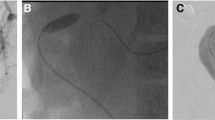Abstract
Purpose
PTC and stenting procedures are associated with significant risks including life-threatening haemorrhage, sepsis, renal failure and high mortality rates. PTC tract closure methods are utilised to reduce haemorrhagic complications despite little evidence to support their use. The current study assesses the incidence of haemorrhagic complications following PTC and stenting procedures, both prior to and following the introduction of a dedicated expanding gelatin foam-targeted embolisation liver tract closure technique.
Materials and Methods
Haemorrhagic complications were retrospectively identified in patients undergoing PTC procedures both prior to (subgroup 1) and following (subgroup 2) the introduction of a dedicated targeted liver tract closure method between 9/11/2010 and 10/08/2012 in a single tertiary referral centre. Mean blood Hb decrease following PTC was established in subgroups 1 and 2. Kaplan–Meier life-table analysis was performed to compare survival outcomes between subgroups using the log-rank test.
Results
Haemorrhagic complications were significantly reduced following the introduction of the targeted PTC tract closure method [(12 vs. 3 % of subgroups 1 (n = 101) and 2 (n = 92), respectively (p = 0.027)]. Mean blood Hb decrease following PTC was 1.40 versus 0.68 g/dL in subgroups 1 and 2, respectively (p = 0.069). 30-day mortality was 14 and 12 % in subgroups 1 and 2, respectively. 50 % of the entire cohort had died by 174 days post-PTC.
Conclusion
Introduction of liver tract embolisation significantly reduced haemorrhagic complications in our patient cohort. Utilisation of this method has the potential to reduce the morbidity and mortality burden associated with post-PTC haemorrhage by preventing bleeding from the liver access tract.




Similar content being viewed by others
References
Van Delden OM, Laméris JS (2008) Percutaneous drainage and stenting for palliation of malignant bile duct obstruction. Eur Radiol 18(3):448–456
Tapping CR, Byass OR, Cast JEI (2011) Percutaneous transhepatic biliary drainage (PTBD) with or without stenting-complications, re-stent rate and a new risk stratification score. Eur Radiol 21(9):1948–1955
Uberoi R, Das N, Moss J, Robertson I (2012) British Society of Interventional Radiology: Biliary Drainage and Stenting Registry (BDSR). Cardiovasc Intervent Radiol 35(1):127–138
Winick AB, Waybill PN, Venbrux AC (2001) Complications of percutaneous transhepatic biliary interventions. Tech Vasc Interv Radiol 4(3):200–206
Dollinger M, Goessmann H, Mueller-Wille R, Wohlgemuth WA, Stroszczynski C, Heiss P (2014) Percutaneous transhepatic and transsplenic portal vein access: embolization of the puncture tract using amplatzer vascular plugs. RöFo Fortschritte Auf Dem Geb Röntgenstrahlen Nukl 186(2):142–150
Allison DJ, Adam A (1988) Percutaneous liver biopsy and track embolization with steel coils. Radiology 169(1):261–263
Cekirge S, Akhan O, Ozmen M, Saatçi I, Besim A (1997) Malignant biliary obstruction complicated by ascites: closure of the transhepatic tract with cyanoacrylate glue after placement of an endoprosthesis. Cardiovasc Intervent Radiol 20(3):228–231
Saad WEA, Madoff DC (2012) Percutaneous portal vein access and transhepatic tract hemostasis. Semin Interv Radiol. 29(2):71–80
Lyon SM, Terhaar O, Given MF, O’Dwyer HM, McGrath FP, Lee MJ (2006) Percutaneous embolization of transhepatic tracks for biliary intervention. Cardiovasc Intervent Radiol 29(6):1011–1014
Choi SH, Gwon DI, Ko G-Y, Sung K-B, Yoon H-K, Shin JH et al (2011) Hepatic arterial injuries in 3110 patients following percutaneous transhepatic biliary drainage. Radiology 261(3):969–975
Fidelman N, Bloom AI, Kerlan RK Jr, Laberge JM, Wilson MW, Ring EJ et al (2008) Hepatic arterial injuries after percutaneous biliary interventions in the era of laparoscopic surgery and liver transplantation: experience with 930 patients. Radiology 247(3):880–886
Chin MW, Enns R (2010) Hemobilia. Curr Gastroenterol Rep 12(2):121–129
Cao H, Liu J, Li T, Cao G, Xu G, Zhai S et al (2013) Interventional therapy for the treatment of severe hemobilia after percutaneous transhepatic cholangial drainage: a case series. Int Surg 98(3):223–228
Marynissen T, Maleux G, Heye S, Vaninbroukx J, Laleman W, Cassiman D et al (2012) Transcatheter arterial embolization for iatrogenic hemobilia is a safe and effective procedure: case series and review of the literature. Eur J Gastroenterol Hepatol 24(8):905–909
Monden M, Okamura J, Kobayashi N, Shibata N, Horikawa S, Fujimoto T et al (1980) Hemobilia after percutaneous transhepatic biliary drainage. Arch Surg 115(2):161–164
Uller W, Müller-Wille R, Grothues D, Schelling J, Zausig N, Loss M et al (2014) Gelfoam for closure of large percutaneous transhepatic and transsplenic puncture tracts in pediatric patients. RöFo Fortschritte Auf Dem Geb Röntgenstrahlen Nukl 186(7):693–697
Saad WEA, Wallace MJ, Wojak JC, Kundu S, Cardella JF (2010) Quality improvement guidelines for percutaneous transhepatic cholangiography, biliary drainage, and percutaneous cholecystostomy. J Vasc Interv Radiol JVIR 21(6):789–795
Krokidis M, Orgera G, Fanelli F, Hatzidakis A (2011) Covered biliary metal stents: which, where, when? Gastrointest Endosc 74(5):1173–1174
Chu HH, Kim H-C, Jae HJ, Yi N-J, Lee K-W, Suh K-S et al (2012) Percutaneous transsplenic access to the portal vein for management of vascular complication in patients with chronic liver disease. Cardiovasc Intervent Radiol 35(6):1388–1395
Tuite DJ, Rehman J, Davies MH, Patel JV, Nicholson AA, Kessel DO (2007) Percutaneous transsplenic access in the management of bleeding varices from chronic portal vein thrombosis. J Vasc Interv Radiol JVIR. 18(12):1571–1575
Günther RW, Schild H, Thelen M (1988) Percutaneous transhepatic biliary drainage: experience with 311 procedures. Cardiovasc Intervent Radiol 11(2):65–71
Sut M, Kennedy R, McNamee J, Collins A, Clements B (2010) Long-term results of percutaneous transhepatic cholangiographic drainage for palliation of malignant biliary obstruction. J Palliat Med. 13(11):1311–1313
Conflict of interest
Adam P. Dale, Rafeh Khan, Anup Mathew, Naomi O. Hersey, Robert Peck, Frederick Lee and Stephen D. Goode declare that they have no conflict(s) of interest.
Human and Animal Rights and Informed Consent
This article does not contain any studies with human or animal subjects.
Author information
Authors and Affiliations
Corresponding author
Rights and permissions
About this article
Cite this article
Dale, A.P., Khan, R., Mathew, A. et al. Hepatic Tract Plug-Embolisation After Biliary Stenting. Is It Worthwhile?. Cardiovasc Intervent Radiol 38, 1244–1251 (2015). https://doi.org/10.1007/s00270-015-1058-7
Received:
Accepted:
Published:
Issue Date:
DOI: https://doi.org/10.1007/s00270-015-1058-7




